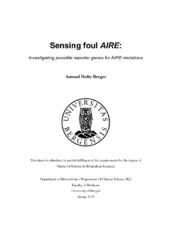| dc.description.abstract | The autoimmune regulator protein, known as AIRE, is a potent transcriptional regulator active in medullary thymic epithelial cells (mTECs) of the thymus, where it is able to switch on the expression of thousands of genes commonly only expressed in specialised peripheral tissues. This ability of AIRE makes it a crucial component in the immune system, specifically for the process of negative selection, in which T-cells are evaluated in their ability to recognise the body’s own proteins. This works as a check-point to avoid autoimmunity, and T-cells that bind to AIRE induced proteins are terminated as they are considered dangerous for the organism. Disruption of AIRE function by mutations leads to the disease autoimmune polyendocrine syndrome type 1 (APS-1), in which autoimmune T-cells initiate destructive processes affecting a variety of functions in the body. Clinically, APS-1 is defined as the presence of at least two out of three major manifestations: Addison’s disease (adrenal insufficiency), hypoparathyroidism and chronic mucocutaneous candidosis. However, patients may not necessarily present the major manifestations, and may also exhibit a variety of other manifestations, both of which may be related to the severity of the underlying mutation. AIRE consists of a number of functional domains; a CARD sequence used for AIRE dimerisation, a SAND domain for general DNA interaction, and two PHD zinc fingers, one used for histone interaction, and the other for protein recruitment and interaction. AIRE induction works in a stochastic manner, targeting genes that are passively downregulated by methylated histone marks, or that are otherwise actively repressed. Therefore AIRE induced genes differ between cells because of the sheer amount of inducible genes, as well as between different cell types, because different cell types will repress different genes. In order to study AIRE function and inform larger sequencing and GWAS studies, we are aiming to develop a functional screening assay for AIRE mutations, using a deep mutational scanning approach. This would attempt to characterise the functional effect of any hypothetical mutation within AIRE and would require a robust reporter gene. This would be a gene with high expression in AIRE wildtype, but low expression in an AIRE mutant, while preferably encoding a cell surface protein for easier FACS sorting. To identify these reporter genes we aimed to develop a robust cell system with AIRE. This cell system needed to be amenable to large-scale transfection and FACS sorting, and be robustly expressing functional AIRE proteins. We, therefore, investigated the expression of known AIRE reporter genes, curated from the literature, and evaluated the usability of these genes as possible reporters. Furthermore, we developed a protocol for AIRE inducible gene discovery using RNA sequencing and evaluated different methodological approaches to this. We successfully established a robust cell system based on AIRE transfected HEK293FT cells, which exhibited substantial AIRE expression. By using qPCR probes for known AIRE induced genes, we also confirmed that AIRE was functionally active. We found that the previously reported AIRE regulated genes KRT14 and S100A8 could be used as reporter genes based on lower expression in selected AIRE mutants. We found that RNAseq is highly consistent between experiments and across methodological approaches when it comes to library preparation, and correlates well with results using qPCR. However, we were unable to identify new reporter genes fitting our criteria, and the reporter gene candidates KRT14 and S100A8 were too weakly expressed to be detected by RNAseq. Comparing the AIRE wildtype with untransfected cells yielded substantial transcriptome differences, consistent with the literature, yet did not yield usable reporter genes. Comparing the AIRE mutants R257X and C311Y with the wildtype, in order to find downregulated genes in the mutants, we found a large population of upregulated genes in the R257X mutant and little difference between C311Y and wildtype. Neither of these mutants has previously been investigated using transcriptome analysis, and so it is uncertain how representative these results are, but they are consistent across our experiments. Western blot analysis showed some degradation in all transfected populations, yet substantial degradation of the C311Y mutant, suggesting a possible instability in this variant. AIRE is a fascinating transcriptional regulator able to induce the expression of repressed genes, but the knowledge of AIRE and its function is still incomplete. The failure of our RNAseq approach to detect AIRE reporter genes indicates that changes in methodology are required. Such changes may still render a deep mutational scanning approach a viable option for the purpose of studying AIRE. | en_US |
